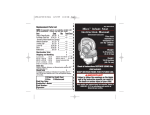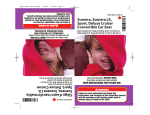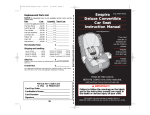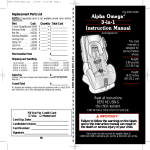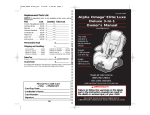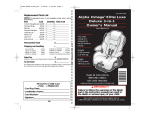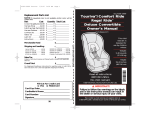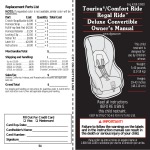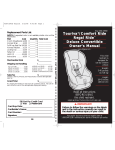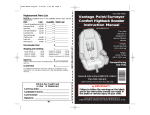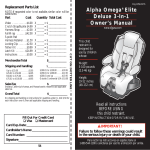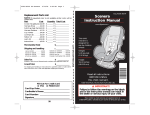Download Maxi-Cosi Mico Instruction manual
Transcript
A. Before You Begin .................Pages 3-8 A-1 Thank You... A-2 Registration and Safety Notices A-3 Understanding Your Child Restraint B. Safety Information .............Pages 9-11 B-1 Vehicle Seating Position B-2 Installation in Vehicle B-3 Child Restraint Use C. Basic Use ...........................Pages 12-33 C-1 C-2 C-3 C-4 C-5 C-6 C-7 C-8 C-9 C-10 C-11 C-12 Remove and Install the Child Restraint to Base Reclining the Base Carrier Use Child Restraint Use Preparing Child Restraint to Fit Your Child Securing Child in Child Restraint Remove Child from Child Restraint Removing Harness System Removing Pad for Cleaning Installing Canopy Installing Harness System Accessories (on select models) 1 D. General Vehicle Installation ........................Pages 34-46 D-1 D-2 D-3 D-4 D-5 D-6 D-7 Understanding Your Vehicle Vehicle Seating Position Choosing LATCH or Vehicle Belts Knowing Your Vehicle Belts Using the Locking Clip Installing on Aircraft Storing LATCH System E. Vehicle Installation........... Pages 47-61 E-1 Rear-Facing Installation with Base E-2 Preparing to Install Base with LATCH E-3 Installing Base with LATCH E-4 Installing Base with Vehicle Belts E-5 Rear-Facing Installation without Base E-6 Installing Child Restraint with Vehicle Belts E-7 Using Locking Clip 2 A-2 Registration and Safety Notices Thank you for choosing this car seat, referred to throughout this manual as a child restraint. The Maxi-Cosi® brand is part of the DJG family and is committed to creating a child restraint with the most comfort and convenience available today. Remember, parents are a child’s first teachers and examples. If you always buckle your seat belt, your child will think it is the natural thing to do. Make it a firm rule that the vehicle does not go until everyone is buckled up. Make no exceptions. No one can predict if use of a child restraint will prevent injury or death in a particular crash. However, combined with careful driving, proper use of a child restraint can lower a child’s risk of injury or death in most crashes. Your child’s safety is worth the time it will take to read and follow these instructions. After reading, if you still have questions or have any problems with this child restraint, please contact our Consumer Relations Department at: Please complete the postage-paid registration card that came with your child restraint, and send it to us. Child restraints could be recalled for safety reasons. You must register this restraint to be reached in a recall. Send your name, address, email address if available, and the restraint’s model number and manufacturing date to: Dorel Juvenile Group, Inc. PO Box 2609, Columbus, IN 47202-2609 Attn: Consumer Relations or call 1-800-951-4113 or register online at www. djgusa.com/registration/carseat/us. For recall information, call the U.S. Government’s Vehicle Safety Hotline at 1–888–327–4236 (TTY: 1–800–424–9153), or go to http://www.NHTSA.gov If you don’t have the card or if Manufacture Model your address Date Number changes, you will find the model number and manufactured date on the label located on back of plastic shell. Maxi-Cosi Website: http://www.maxi-cosi.com Fax: 1-800-207-8182 Mailing Address: Dorel Juvenile Group, Inc. P.O. Box 2609 Columbus, IN 47202-2609 Telephone: 1-800-951-4113 8 A.M. to 6 P.M. EST M-TH, 8 A.M. to 4:30 P.M. EST FRI 3 4 A. Before You Begin A-1 Thank You... A-3 Understanding Your Child Restraint Front View Back View A. B. B. C. H. D. J. I. L. K. E. F. G. A. Carry handle B. Canopy E. Harness Release Lever (under flap) C. Stroller Release Buttons F. Harness Tightening Strap D. Rear-Facing Belt Path (when used without the base) G. Removable Base H. Instruction Manual Storage (under the pad) 5 I. Handle Adjustment Button J. Base Release Handle K. Base Adjustment Handle L. Shell Harness System Detail M. N. L. M. N. O. P. Q. R. 6 Infant Head Insert Harness Covers Chest Clip Harness Straps Buckle Tongue Buckle Buckle Cover Buckle Strap Buckle Strap Slots A. Before You Begin A. Top of Base Bottom of Child Restraint B. H. G. J. C. D. F. I. E. G. Base Belt Path Openings A. Base Release Handle E. Harness Tightening Strap H. Locking Bars B. Harness Slots F. Buckle’s Metal Retainer I. Base Adjustment Handle C. Harness Straps J. J. LATCH Storage D. Splitter Plate 7 8 A. Before You Begin A. Failure to follow these warnings can result in the serious injury or death of your child. To help you recognize instructions which are most critical to your child’s safety, we use this symbol: This child restraint should be securely belted in the vehicle even when not in use. In a crash or sudden stop, an unsecured child restraint could injure occupants. Do not use a child restraint that has been in a crash. You must get a new child restraint. Never place a child rearfacing in a seating position with an active frontal airbag. Check the vehicle owner’s manual for more information about air bag/child restraint use. For vehicles without a back seat, refer to your vehicle owner’s manual. B-2 Installation in Vehicle Check the vehicle belt or LATCH belt before each use. Use only if the belt is tightened properly and securely. 9 B-3 Child Restraint Use This child restraint must only be used when the child weighs between 5-22 lbs. (2.3-10 kg). Never take your child out of the child restraint while the vehicle is moving. Never leave child unattended. Placing your child in a hot child restraint may result in burns. Do not use a child restraint with damaged or missing parts. Do not use cut, frayed or damaged harnesses. 10 B. Safety Information B-1 Vehicle Seating Position Do not lubricate buckles and fasteners. Do not substitute parts or try to modify the child restraint in any way. Do not use any child restraint accessory except those approved by Dorel Juvenile Group. Never allow any child to play with this child restraint; it is not a toy. Do not remove or cover up any of the warning labels or other labels on the child restraint. Read all instructions for additional warnings. To Remove Child Restraint from Base From the back of the child restraint, slide the base release handle up the back of the child restraint and lift the restraint out of the base. To Attach Child Restraint to Base Align the slots on the side of child restraint with the locking bars in the base. Push down firmly on the carrying handle and the front of the child restraint to lock child restraint to base. You will hear a “click” when it is locked. Pull up on child restraint’s front two corners to make sure the front of the child restraint is locked to the base. 12 C. Basic Use 11 C-1 Remove and Install the Child Restraint to Base C-2 Reclining the Base C-3 Carrier Use To Adjust Carrying Handle Squeeze both adjustment buttons on each side of the carrying handle. Rotate up or down to desired location. Release buttons. To Adjust the Base From the back of the base, pull out on the base recline handle and either lift or lower front of base. The base has multiple recline positions. Make sure both carrying handle adjuster buttons are in the locked position. When carrying, handle must be upright. NOTE: The carrying handle can be in any position when installed in the vehicle. 13 14 C. Basic Use DO NOT use in the seating area or across the top of shopping carts. WARNING: 15 This child restraint is to be used rear-facing with children weighing 5-22 lbs (2.3-10 kg) AND 19-29 inches tall (48-74 cm). NOTE: If your child does not meet the criteria for the Rear-Facing position, do not use this child restraint. 5-22 lbs (2.3-10 kg) and 19”-29” tall (4874cm) Rear-Facing with base: Child and child restraint with base face the back of the vehicle and are placed in the back seat. 5-22 lbs (2.3-10 kg) and 19”-29” tall (4874 cm) Rear-Facing without base: Child and child restraint without base face the back of the vehicle and are placed in the back seat. 16 C. Basic Use Read ALL instructions before using child restraint as a carrier. NEVER use carrier unless child is properly secured. Use only as a carrier by children weighing 5-22 pounds (2.3-10 kg) and 19-29 inches (48-74 cm) or less. NEVER leave child unattended. Always keep child within arm’s reach. Suffocation Hazard: Infant carrier can roll over on soft surfaces and suffocate child. NEVER place carrier on beds, sofas or other soft surfaces. Strangulation Hazard: Children have STRANGLED in loose or partially buckled harness straps. Fully restrain the child even when carrier is used outside the vehicle. Fall Hazard: Child’s movement can slide carrier. NEVER place carrier near edges of counter tops, tables or other elevated surfaces. Do not use the carrier if it is damaged or broken, or if any parts are missing. C-4 Child Restraint Use C-5 Preparing Child Restraint to Fit Your Child 3. Release Chest Clip Press on chest clip release button and pull apart. Make these adjustments with your child in the child restraint before you install in the vehicle. 1. To Remove Child Restraint From Base From the back of the child restraint, slide the base release handle up the back of the child restraint and lift the restraint out of the base. Press red button. Pull buckle tongues out. Place harness straps over sides of child restraint. 5. Place Child in Child Restraint Push down on the harness release lever (under flap on the front of child restraint) while pulling out on both harness straps. 17 Place the child’s bottom and back flat against the child restraint. This will increase comfort and allow the harness straps to be properly tightened. 18 C. Basic Use 2. Loosen Harness 4. Unbuckle Harness Rear-Facing Position a. From the front of child restraint, pull harness straps out. Harness slot must be even with or just below the shoulders. If the bottom harness slots are above the child’s shoulders, do not use this child restraint. b. Rethread harness into new harness slot location. Make sure harness straps do not twist. 6. Check Harness Height Determine which set of harness slots works best for your child. Adjust if needed. c. From the back of the child restraint, refasten the harness straps to the splitter plate. Location With harness system loose, from the back, remove harness from the splitter plate. 19 NOTE: Make sure the harness straps and harness adjustment strap are not twisted. 20 C. Basic Use 7. To Change Harness a. To Change Buckle 1” Position Do not use this child restraint if the top of your child’s head is within one inch from the top of the child restraint. Make sure the harness height is correct for your child’s size. Remove child. From under the seat, insert buckle’s metal retainer up through the child restraint and pad. b. Choose new location and push the metal retainer through pad and child restraint. Make sure the buckle is facing out. Make sure you have reinstalled the harness system correctly. Failure to follow these steps can result in serious injury or death. c. Pull on the buckle to 8. Check Buckle Position Determine which of the available buckle positions will be most comfortable and provide a snug fit for your child. 21 Failure to reinstall the harness system correctly can result in serious injury or death. 22 C. Basic Use check to make sure buckle’s metal retainer is completely inserted through the pad and child restraint. C-6 Securing Child in Child Restraint 1. Position Harness Straps Over the Child’s Shoulders. 2. Buckle Push each buckle plate into buckle until you hear a “click”. Remember to always pull up on harness straps to make sure buckle is locked tightly. 3. Close Chest Clip Insert right half of chest clip into left half and snap together. 23 24 C. Basic Use DO NOT put snowsuits or bulky garments on your infant when placing them in the child restraint. Bulky clothing can prevent the harness straps from being tightened properly. To keep infant warm, buckle your infant in the child restraint and place a blanket around the infant or place the infant’s coat on backwards after buckling in. Failure to follow these steps can result in serious injury or death. 4. Tighten Harness 7. Position Chest Clip The chest clip must be placed at mid-chest (even with armpits) and away from the child’s neck. Pull on harness tightening strap to tighten harness snugly. NOTE: A snug strap should not allow any slack. It lies in a relatively straight line without sagging. It does not press on the child’s flesh or push the child’s body into an unnatural position. Failure to fasten and tighten the harness system correctly and snugly can result in serious injury or death. 8. Attach Harness Adjustment Strap End to Shell 5. Check Harness Tightness Try to pinch the harness at the shoulders. If you can pinch the harness strap, tighten more. If your fingers slip off, the harness is tight enough. 25 26 The end of the harness adjustment strap has a loop. Slide one side of the loop onto one tab and the other end on the other tab. Replace the pad over the front of the shell. C. Basic Use Pull up the pad at the front of the shell. C-7 Removing Child From Child Restraint C-8 Removing Harness System For Cleaning 1. Loosen Harness 1. Remove Harness Straps from Splitter Plate Pushing down on the harness release lever (under flap on the front of child restraint) while pulling on both harness straps above the buckle to loosen. Fully loosen harness straps. Locate splitter plate on the back of the child restraint and unfasten the harness straps. 2. Release Chest Clip 1 Press on release button and pull apart. 2. Remove Harness Straps Pull harness through the slots from the front (1). 3. Unbuckle Unthread harness from the chest clip (2). 3 Unthread harness from the buckle tongues (3). Press red button on buckle to release the buckle tongues. Move harness away from child and remove child. 27 The harness straps do not need to be completely removed from the shell to remove the pad for cleaning. 28 C. Basic Use 2 C-9 Removing Pad for Cleaning 4. Remove Canopy Press in on canopy tab locks on canopy post and pull the canopy hoop off the posts. Remove canopy off of the hoop. You must follow the instructions on how to remove the harness system before you can remove the pad. 1. Pull Pad Off the Pad Tabs To release the tab, pull down on the pad and pull the tab out of the child restraint. Cleaning Pad Hand wash pad with warm sudsy water, rinse clean and air dry. Spot clean the harness straps. Do not use bleach or use other harsh cleaners. Do not dry clean or machine wash. 2. Remove Buckle 3. From the Top, Pull Pad Off the Shell 29 Do not use child restraint without the pad. Replace child restraint pad by reversing order; Starting from top of the child restraint, slip pad on plastic shell; insert buckle and pull harness tightening strap through pad. Slip pad over front of the plastic shell. Attach pad to the tabs on the sides of plastic shell. Replace the canopy (see section C-10). Rethread harness (see section C-11). 30 C. Basic Use Remove the buckle by inserting the metal retainer up and through the shell and pad. See section C-5. C-10 Installing Canopy C-11 Installing Harness System 1. Check Canopy Hoop Angle The canopy hoop has an angle that will make the canopy lean forward when installed. Make sure when you thread the canopy hoop, the angle is correct. 3 1. From the front, make harness ends even with each other. Thread harness straps through each buckle tongue from the back to the front (1), thread through chest clip (2) and push harness ends through slots in the seat back (3). Do not twist the harness. 2 1 2. Thread Plastic Strip Completely Through Channel on the Front Edge of Canopy 2. From the back of the NOTE: Make sure the harness straps and harness adjustment strap are not twisted. 3. Attach Canopy Fit back of canopy over back of shell. Snap each plastic strip end to each canopy post. 31 Failure to reinstall the harness system can result in serious injury or death. 32 C. Basic Use child restraint, attach the harness straps to the splitter plate. D-1 Understanding Your Vehicle Infant Insert: When using insert, make sure insert does not cover your infant’s face in any way. To adjust the insert, slide the top together or apart for proper fit. Remove the insert for older babies. To remove insert: Unthread the harness from the splitter plate (see “Preparing Child Restraint to Fit Your Child” section), remove insert, and rethread harness. Reverse to replace insert. Harness Covers: Harness covers help provide comfort to the neck. For harness covers to fit correctly, you may have to fit the upper ends of the covers through the harness slots. To remove, unthread harness from splitter plate (see “Preparing Child Restraint to Fit Your Child” section). Slide covers off and reattach harness. 33 Your vehicle’s features may be considerably different than those pictured here. Consult your vehicle owner’s manual to help identify your vehicle’s specific features and locations. Seat Bight Air Bags Consult your vehicle owner’s manual for all air bag locations. Vehicle Seat Belts Consult your vehicle owner’s manual for vehicle belt use. LATCH Anchors Located in the seat bight. 34 D. General Vehicle Installation C-12 Accessories To avoid your child being seriously burned, take the following precautions: 1. Park in the shade or where sun does not directly hit the child restraint. 2. Cover the child restraint with a sheet or blanket when not in use. 3. Check for hot child restraint and buckles before placing child in child restraint. To help protect your vehicle seat’s upholstery from damage, use a single layered towel underneath and behind child restraint. D-2 Vehicle Seating Position Some seating positions in your vehicle may not be safe for this child restraint. Some vehicles do not have a seating position that can be used safely with this child restraint. If you are not sure where to place the child restraint in your vehicle, consult your vehicle owner’s manual or contact Dorel Juvenile Group Consumer Relations Dept. 35 Never place a child rear-facing in a seating position with an active frontal airbag. This can result in serious injury or death. Use the child restraint only on vehicle seats that face forward. Do not use on seats that face the sides or rear of the vehicle. Safety Tip: Children are safer when properly restrained in rear seating positions than in the front seating positions. 36 D. General Vehicle Installation Safety Tip: Vehicle Belts According to National Highway Traffic Safety Administration information, children in rear seating positions are statistically safer, whether you have air bags, advanced air bags, or no air bags at all. If LATCH is not an option, you must use the vehicle seat belt system to install the child restraint. There are some vehicle belts that will not work with a child restraint or will require special attention. D-3 Choosing LATCH or Vehicle Belts See next page and check your vehicle’s owner’s manual for specific instructions. LATCH Anchor Bars The LATCH System LATCH (Lower Anchors and Tethers for CHildren) is a universal system for installing child restraints without using vehicle seat belts. The LATCH system can ONLY be used in vehicles that have the LATCH anchor bars installed and designated LATCH seating positions. Most vehicles manufactured after September 2002 are equipped with LATCH. Check your vehicle owner’s manual to see which seating positions may be equipped with the LATCH system. 37 Do not use both the LATCH belt and vehicle belt at the same time. D-4 Knowing Your Vehicle Belts Review your vehicle’s owner manual for vehicle seat belt use with child restraints. This is your best source for information concerning your vehicle. Not all vehicle belts will work with this child restraint. This child restraint must be tightly locked in place at all times, during travel. You must determine if your vehicles belts are compatible with this child restraint. 38 D. General Vehicle Installation Safety Tip: • Automatic/Passive vehicle seat belts You MUST have a vehicle lap belt to install any child restraint. An automatic (passive) shoulder vehicle belt may or may not have a separate vehicle lap belt. Consult your vehicle owner’s manual. • Vehicle belts in center of the door or side panel You must move the child restraint to another seating location. Consult your vehicle owner’s manual. • Vehicle belts that are in front of the seat bight You may need to move the child restraint to another seating location. Consult your vehicle owner’s manual. • Do Not Use with inflatable seat belts You may need to move the child restraint to another seating location or use LATCH belts only. • ELR (Emergency Locking Retractor) vehicle belts These lap and shoulder vehicle belts only lock in a sudden stop or crash, and do not properly secure a child restraint alone. Consult your vehicle owner’s manual. 39 To learn if you have this type of vehicle belt, gently pull the vehicle belt all the way out of the retractor (spool), let it return several inches, then pull on it again. If it moves freely, it is an ELR vehicle belt. If it is locked and will not allow any more vehicle belt to come out, it is a switchable retractor. ELR lap-only vehicle belts MUST NOT be used with this child restraint. • Switchable retractor These vehicle belts switch from ELR to ALR (Automatic Locking Retractor). You must have the vehicle belts in the locking mode to use them. Follow the instructions in the installation sections. • ALR (Automatic Locking Retractor) These vehicle belts lock after pulling the webbing out and letting the vehicle belt go back into the retractor an inch or two. Follow the instructions in the installation sections. 40 D. General Vehicle Installation Vehicle Belts D-5 Using the Locking Clip • Check the Latch Locking Plates on Your Lap and Shoulder Belt Latch Plate Grasp the tongue portion of the latch plate (the part that goes Sliding inside the buckle) and Latch pull straight out, inline Plate with the vehicle lap belt. If the latch plate does not slide up and down the vehicle belt, you have a locking latch plate. You should not need to use a locking clip. Consult your vehicle owner’s manual. You will rarely need to use a locking clip except for in some older vehicles. Built in child restraint locking systems have been required in vehicles since 1996, and many vehicles had these features even earlier. Check your vehicle owner’s manual to learn how to use the systems in your vehicle. If you need a locking clip, please go back to the store where you purchased this child restraint and purchase one or call us at 1-800-544-1108 to order one. Locking clips from any child restraint manufacturer are okay to use. A locking clip will not fix all types of seat belt problems. Review section D-4 and your vehicle’s owner manual for vehicle seat belt use with child restraints. Before you put your child restraint in the vehicle, buckle the lap/shoulder belt. Pull on the lap belt portion. If it loosens or slips, you must either use a locking clip to hold the seat belt tight or move the child restraint to another seating location. If the latch plate slides up and down on the vehicle belt, and you have an ELR retractor, you MUST use a locking clip to install the child restraint. You may not need to use the locking clip with a switchable or ALR retractor. Consult your vehicle owner’s manual. 41 42 D. General Vehicle Installation Vehicle Latch Plates Rear-Facing Thread vehicle lap belt through the belt path as shown. Buckle. 2. Tighten Vehicle Belt 4. Attach Locking Clip Thread both portions of the vehicle belt onto the locking clip, as close to the latch plate as possible. 5. Position Locking Clip Push down firmly on the base and pull up on the shoulder belt to tighten Position locking clip about 1 in. (2.5 cm) from vehicle belt’s latch plate. Rebuckle vehicle belt. 6. Check Vehicle Belt Tightness 3. Locate Locking Clip Location Grasp both vehicle belts together just behind the latch plate and unbuckle. NOTE: If the latch plate ends up just at the belt path opening so you cannot grasp the vehicle belt at the latch plate, grasp the vehicle belts on the opposite side of the child restraint, as close to the latch plate as possible. Install the locking clip on the latch plate end, as close as possible. Grasp the base at the vehicle belt path with one hand. Push and pull the base from side to side, forward and back. The base should not move more than 1 inch. NOTE: If base moves more than 1 inch, redo all of the steps or try another seating location. Remove the locking clip when the vehicle seat belt is not being used with a child restraint. 43 44 D. General Vehicle Installation 1. Place Base in Vehicle for use on the child restraint. See section E-6 for vehicle belt step by step installation. NOTE: The carrying handle can be in any position when installed in the vehicle. D-7 Storing LATCH System Failure to securely store the LATCH system can result in serious injury or death. Store LATCH By Connecting the LATCH Connectors to Side of Base as Shown D-6 Installing on Aircraft This restraint is certified for aircraft use. Use only on forwardfacing aircraft seats. Follow instructions for vehicle installation. Contact the airline for their specific policies. 45 46 D. General Vehicle Installation 7. Same steps apply E-1 Rear-Facing Installation with Base Never place a child rear-facing in a seating position with an active frontal airbag. This can result in serious injury or death. This child restraint must always face the rear of the vehicle when installed. LATCH Belt Lap/Shoulder Belt 1. Remove LATCH from Storage To use LATCH, unhook LATCH connectors from base by pressing the red release button on each connector. 2. Thread the LATCH belt through belt path as shown. NOTE: Adjuster MUST be on the left side of child restraint as shown. Do Not twist belt. Lap Belt 47 48 E. Installing Rear-Facing E-2 Preparing to Install Base with LATCH E-3 Installing Base with LATCH 2. Connect LATCH to Vehicle LATCH Anchor Fasten one LATCH belt connector to the anchor in the vehicle seat located in the vehicle seat bight. Repeat for other side of base. See your vehicle owner’s manual for information on designated LATCH positions, anchor locations and anchor weights. Do not use the LATCH system along with the vehicle lap or lap/shoulder belt. Check LATCH belt before each use. Use only if the belt can be tightened properly and securely. Failure to follow these warnings can result in serious injury or death. 1. Place Base in Vehicle 3. Tighten LATCH Belt Rear-Facing Push down firmly on the base and pull up on the free end of belt to tighten. Center the base between the vehicle anchors in the chosen seating position. 49 50 E. Installing Rear-Facing NOTE: Make sure arrows on connectors are facing up. 4. Check LATCH Belt Tightness 5. Attach Child Restraint to Base With child secured in child restraint, attach to base. Align the slots on the side of child restraint with the locking bars in the base. Push down firmly on the carrying handle and the front of the child restraint to lock child restraint to base. You will hear a “click” when it is locked. Pull up on child restraint’s front two corners to make sure the front of the child restraint is locked to the base. 51 Failure to securely attach child restraint to base can result in serious injury or death. 6. Check for Proper Recline Make sure level line on side of child restraint is level with the ground. Adjust base if needed. (see section C-2). You may need to place a large rolled towel(s) or foam pool noodle(s) under the front of the base to achieve correct recline angle. Check often to be sure padding is still in place, the level line is still level and the belt is tight. NOTE: The carrying handle can be in any position when installed in the vehicle. 7. To Release LATCH 52 Remove LATCH from vehicle anchors by pressing the red release button on each connector. E. Installing Rear-Facing Grasp the base at the belt path with one hand. Push and pull the base from side to side, forward and back. The base should not move more than 1 inch. NOTE: If base moves more than 1 inch, try reinstalling the base or try another seating location. E-4 Installing Base with Vehicle Belts NOTE: Review section D-4 to help determine what kind of vehicle seat belts you have. Review your vehicle’s owner manual for vehicle seat belt use. 1. Store LATCH Belts You MUST store the LATCH system when using the vehicle seat belts. See section D-7. 53 Rear-Facing Center the base in the chosen seating position. 3. Thread Vehicle Belt Thread the vehicle lap or lap/shoulder belt combination through belt path as shown. With an ALR belt, pull the belt all the way out before threading the base. 4. Tighten Vehicle Belt Push down firmly on the base and pull up on the shoulder belt to tighten. With a switchable retractor, pull the vehicle shoulder belt all the way out to switch the retractor into the ALR mode before tightening. Feed the slack back into the retractor while tightening. 54 E. Installing Rear-Facing Do not use the LATCH system along with the vehicle lap or lap/shoulder belt. Store LATCH belts when using the vehicle belts. Check the vehicle belt before each use. Use only if the belt is tightened properly and securely. Failure to follow these warnings can result in serious injury or death. 2. Place Base in Vehicle 5. Check Vehicle Belt Tightness Failure to securely attach child restraint to base can result in serious injury or death. 7. Check for Proper Recline Make sure level line on side of child restraint is level with the ground. Adjust base if needed. (see section C-2). You may need to place a large rolled towel(s) or foam pool noodle(s) under the front of the base to achieve correct recline angle. Check often to be sure padding is still in place, the level to ground line is level and the belt is tight. 6. Attach Child Restraint to Base With child secured in child restraint, attach to base. Align the slots on the side of child restraint with the locking bars in the base. Push down firmly on the carrying handle and the front of the child restraint to lock child restraint to base. You will hear a “click” when it is locked. Pull up on child restraint’s front two corners to make sure the front of the child restraint is locked to the base. 55 56 E. Installing Rear-Facing Grasp the base at the belt path with one hand. Push and pull the base from side to side, forward and back. The base should not move more than 1 inch. NOTE: If base moves more than 1 inch, try reinstalling the base or try another seating location. E-5 Rear-Facing Installation Without Base NOTE: Review section D-4 to help determine what kind of vehicle seat belts you have. Review your vehicle’s owner manual for vehicle seat belt use. 57 58 E. Installing Rear-Facing Lap/Shoulder Belt Lap Belt Never place a child rear-facing in a seating position with an active frontal airbag. This can result in serious injury or death. This child restraint must always face the rear of the vehicle when the child is between 5-22 lbs (2.3-10 kg) and is less than one year old. Do not use the LATCH system along with the vehicle lap or lap/shoulder belt. Store LATCH belts when using the vehicle belts. Check the vehicle belt before each use. Use only if the belt is tightened properly and securely. Failure to follow these warnings can result in serious injury or death. E-6 Installing Child Restraint with Vehicle Belts NOTE: The carrying handle can be in any position when installed in the vehicle. 1. Place Child Restraint in Vehicle RearFacing 2. Thread Vehicle Belt Thread the vehicle lap or lap/shoulder belt combination through shell’s belt path as shown. Buckle vehicle belt. 59 Belt Lay your forearm across child restraint at the belt path while pulling up on belt to tighten. With an ALR belt, pull the belt all the way out before tightening. Feed the slack back into the retractor while tightening. 4. Check for Proper Recline Make sure level line on side of child restraint is level with the ground. Adjust child restraint if needed. You may need to place a large rolled towel(s) or foam pool noodle(s) under the front of the child restraint to achieve correct recline angle. Check often to be sure padding is still in place and the belt is tight. 60 E. Installing Rear-Facing With child secured in child restraint, center the child restraint in the chosen seating position. Check the level to ground line to see if it is level with the ground. Adjust if needed. 3. Tighten Vehicle 5. Check Vehicle Belt Tightness Grasp the child restraint at the belt path with one hand. Push and pull the child restraint from side to side, forward and back. The child restraint should not move more than 1 inch. NOTE: If child restraint moves more than 1 inch, try reinstalling the child restraint or try another seating location. 61 Warranty Dorel Juvenile Group, Inc. (DJG) warrants this product to the original retail purchaser as follows: This product is warranted against defective materials or workmanship for one year from the date of original purchase. An original receipt is required to validate your warranty. DJG will, at its option, provide replacement parts or replace this product. DJG reserves the right to substitute if the part or model has been discontinued. To make a claim under this warranty you may contact us at www.djgusa.com, fax us at 1-800-207-8182 24 hours a day, write to DJG, Consumer Relations Department, P. O. Box 2609, Columbus, IN 47202-2609, or call 1-800-9514113 from 8:00 a.m. to 6:00 p.m. EST Monday through Thursday and from 8:00 a.m. to 4:30 p.m. on Friday. Proof of purchase is required and shipping charges are the responsibility of the consumer. Warranty Limitations: This warranty does not include damages which arise from misuse or abuse of this product. Limitation of Damages: The warranty and remedies as set forth are exclusive and in lieu of all others, oral or written, expressed or implied. In no event will DJG or the dealer selling this product be liable to you for any damages, including incidental or consequential damages, arising out of the use or inability to use this product. 62 Limitation of warranties and other warranty terms and state law rights: Any implied warranties, including implied warranties of the merchantability and fitness for a particular purpose, shall be limited to the duration and terms of the express written warranty. Some states do not allow limitations as to how long an implied warranty lasts or the exclusion or limitation of incidental or consequential damages, so the above limitations may not apply to you. This warranty gives you specific legal rights, and you may have other rights, which vary from state to state. Neither DJG nor the dealer selling this product authorized any person to create for it any other warranty, obligation, or liability in connection with this product. PLEASE COMPLETE AND MAIL THE PRE-ADDRESSED OWNER REGISTRATION CARD WITHIN (30) DAYS OF PURCHASE TO EXPEDITE WARRANTY CLAIMS AND TO VERIFY THE ORIGINAL DATE OF PURCHASE. Return the form with payment to: Dorel Juvenile Group, Inc. Consumer Relations Department P.O. Box 2609 Columbus, IN 47202-2609 Fax orders to: 1-800-207-8182 Please make money orders payable to Dorel Juvenile Group, Inc. Fill in the area below to charge to Visa or Mastercard. We do not accept personal checks or Discover Card. All outside of U.S. and Canada MUST use credit card. Ship To (Please Print): Name: _____________________________________ Address: ___________________________________ City: ______________________________________ State/Province:_____________ Zip_______________ Telephone: _________________________________ Email Address: ______________________________ Replacement Parts Order Form Complete the form below. Your model number with color code and manufacturer date code MUST be included on the form to ensure proper replacement parts. Your model number with color code and the date code can be found on a sticker on the side of child restraint. Payment in U.S. dollars must accompany your order. Choose parts needed from the list on the next page. 63 We MUST have this information to process your order: Model Number (5 digits & 3 letters): __________ Manufacture Date (mm/dd/yyyy): _____________ 64 Replacement Parts List NOTE: If requested color is not available, similar color will be substituted. Pricing may vary per model. Part Cost Qty Total Cost Crotch Strap/Buckle .... $6.99 X _____ = $ _________ Full Wrap Seat Pad.... $45.99 X _____ = $ _________ (includes infant insert, harness covers and canopy) Harness Retainer......... $1.50 X _____ = $ _________ Locking Clip ................ $2.50 X _____ = $ _________ Latch Kit .................... $24.99 X _____ = $ _________ Base .......................... $89.99 X _____ = $ _________ Instructions ................. $0.00 X _____ = $ _________ Merchandise Total: $ _________ Shipping and Handling: $ _________ Up to $25.00 ............. $5.95 $25.01 to $50.00 ...... $6.95 $50.01 to $75.00 ...... $8.95 $75.01 to $100.00 .... $9.95 $100.01 to $150.00 .. $10.95 Sales Tax $150.01 to $200.00 .. $11.95 $200.01 and up ........ $13.95 Outside Continental USA $10.00 $___________ (Indiana, California, Arkansas, and Massachusetts residents add applicable sales tax.) Grand Total $___________ No shipping and handling on instructions for quantities under 6. Add $.50 for each instruction over 6, then add applicable shipping and handling. Fill Out For Credit Card q Visa q Mastercard Card Exp. Date: _______________________ Cardholder’s Name: ____________________ Card Number:_________________________ Signature: ___________________________ 65 66


































